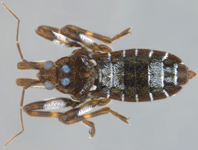Abstract
Most recently, Coimbra et al. (2020) published an article in this journal (Zootaxa, 4729 (2): 177–194) questioning the taxonomic position of the genus Copytus Skogsberg, 1939 (Crustacea, Ostracoda) along with proposing it as the type genus of their new family (Copytidae Coimbra et al., 2020), and erecting two new species that were listed by previous authors as Copytus sp. 1 and Copytus sp. 2. The main diagnostic characteristics of their new proposed family (and the genus Copytus) are the hinge type and muscle scars on the carapace and/or valves (see lines 6–8 from the bottom, p. 179 in Coimbra et al. 2020). They also underlined that (p. 179) “...this study is based exclusively on the morphology of the animals’ hard parts”. While the authors considered another genus (Neocopytus) proposed by Külköylüoğlu, Colin & Kılıç (2007) of the family Neocytherididae as invalid, they interestingly transferred some species of Neocopytus to Copytus as species of their new family (Coimbra et al. 2020). Herein, my point with the comments listed below is to clarify that, when possible, both soft and hard parts should be considered in taxonomy, and such an integrated approach clearly indicates that Neocopytus is a valid and taxonomically useful genus.
References
Athersuch, J., Horne, D.J. & Whittaker, J.E. (1989) Marine and brackish water ostracods (superfamilies Cypridacea and Cytheracea). Keys and notes for the identification of the species. Synopsis of the British Fauna. New Series. Vol. 43. E.J. Brill, Leiden, 361 pp.
Ayress, M.A. (1995) Late Eocene Ostracoda (Crustacea) from the Waihao District, South Canterbury, New Zealand. Journal of Paleontology, 69, 897–921.
https://doi.org/10.1017/S0022336000035563
Brady, G.S. (1868) Description of Ostracoda. In: Folin, A.G. & Perier, L. (Eds.), Les fonds de la mer, étude internationale sur les particularités nouvelles des régions sous-marines, 1, pp. 49–112.
Brady, G.S. (1880) Report on the Ostracoda dredged by H.M.S. Challenger during the Years 1873-1876. Report on the Scientific Results of the Voyage of H.M.S. Challenger during the years 1873–76. Zoology, 1 (part 3), 1–184.
https://doi.org/10.5962/bhl.title.59771
Coimbra, J.C., Bergue, C.T. & Ramos, M.I.F. (2020) Is Copytus Skogsberg, 1939 (Crustacea: Ostracoda) a Neocytherideid? With description of a new family and two new species. Zootaxa, 4729 (2), 177–194.
https://doi.org/10.11646/zootaxa.4729.2.2
Hartmann, G. & Puri, H.S. (1974) Summary of Neontological and Paleontological Classification of Ostracoda. Mitteilungen aus dem hamburgischen zoologischen Museum und Institut, 70, 7–73.
ICZN [International Commission on Zoological Nomenclature]. (1999) International Code of Zoological Nomenclature. 4th Edition. International Trust for Zoological Nomenclature, London, 306 pp.
Külköylüoğlu, O., Colin, J.-P. & Kılıç, M. (2007) Neocopytus, a new genus of marine Ostracoda from the Mediterranean Sea (Turkey). Crustaceana, 80, 979–998.
https://doi.org/10.1163/156854007781681265
Neale J.W. (1967) An ostracod fauna from Halley Bay, Coast Land, British Antarctic Territory. British Antarctic Survey Scientific Reports, 58, 1–59.
Skogsberg, T. (1939) A new genus and species of marine ostracods from South Georgia. Proceedings of the California Academy of Sciences, Series 4, 23, 415–425.
Van Morkhoven, F.P.C.M. (1963) Post-Palaeozoic Ostracoda, their morphology, taxonomy and economic use. Generic descriptions. Elsevier, Amsterdam, 478 pp.
Yassini, I. (1979) Répartition des ostracodes dans une série marine régressive d’âge pliocène dans la région d’Alger, Algérie. Revue de Micropaléontologie, 22, 89–124.


